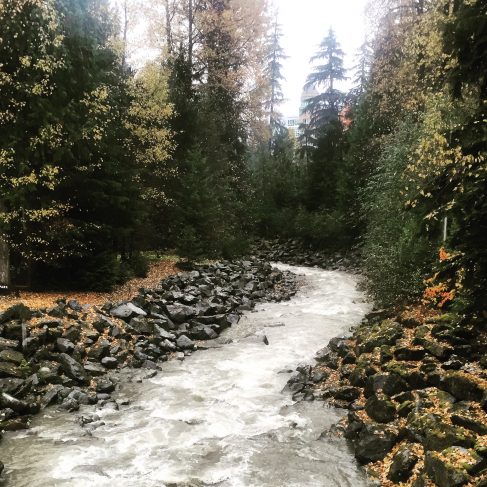Before this year, I had never been to British Columbia. But in May I ran a half marathon at the BMO Vancouver Marathon and on Labour Day weekend, I ran Kelowna’s Wine Country Half Marathon, part of the Destination Race Series. So when I was invited to run a 20K leg (as part of a four person relay team) at the Whistler 50 Mile Ultra & Relay, I felt pretty comfortable if not confident.
Frankly, I was more concerned about two things. First, this was a trail race and I hadn’t run on a trail of any kind since cross country training a couple of decades ago. The second major worry was the wildlife, namely bears and any creature that could end my life. Unwarranted? Maybe a little, but the race course did weave through the more than 40 kilometers of natural park trails that are a big reason active outdoor enthusiasts including runners and skiers are attracted to this naturally gifted resort town.
Needless to say, running in the town that official alpine skiing venue for the Vancouver 2010 Olympics (640 meters at base level) wasn’t on my radar in the way that it should have been. After all elite runners often live at and train at altitude. When you arrive at a destination that’s at a higher altitude than where you’re usually living, your body automatically begins producing new red blood cells, as a means of carrying more oxygen through your body. But you don’t need to be an elite athlete, this process just happens when you’re running a destination race somewhere like Whistler. That said, elite athletes train at this higher elevation and there’s a whole plan that goes along with that type of training.
You don’t have to be an elite to run in the mountains. That said, it will help to keep a few key points in check (which I didn’t but will next time) when you only have a couple of days to acclimatize before race day.

Dial It Back
You want to go faster. Who doesn’t? Whatever the distance, you’ve put in the training, but if you’re used to running at an altitude that’s say 75 meters above sea level (like Toronto) and you’re race is at Whistler’s elevation, then you’re not going to have a PB, you’re just not, get used to that idea. I didn’t expect a PB. But also didn’t bank on having to dial back my speed as much as I did in the last 7 kilometers of that 20K, it wasn’t pretty. Instead, enjoy the mountain views, because no matter the mountain range (Rockies, Sierra Nevada or the Alps) you will never experience anything quite like it.
Hydrate, Hydrate, Hydrate
It’s a no brainer for anyone who has ever trained and raced. But hydration is ever more important at altitude. Why? That’s because as your body acclimates to the elevation, you’ll body naturally increases its breathes per minute which requires added hydration. Dehydration is the number one cause for athlete fatigue, which make it an especially important consideration for anyone racing. Supplementing water with an electrolyte is also a good way to ensure your body is getting what it needs. And save the brews and cocktails for the post-race celebration since alcohol can dehydrate you more quickly in this environment.
Breathe Deeply
Your breaths per minute will naturally increase when you’re at a higher altitude and by being away of your breathing on race day, you’ll be able to better adjust your pace. On race day, stay focused on your form: keep your shoulders down and relaxed and lead with your ches, which will expand your lungs and maximize air intake. Sure we should be doing this all the time, but it’s even more important in order to help maintain steady breathing and avoid hyperventilation, which can happen when you’re racing on a mountain high.






 Our Magazine
Our Magazine Previous Release
Previous Release
